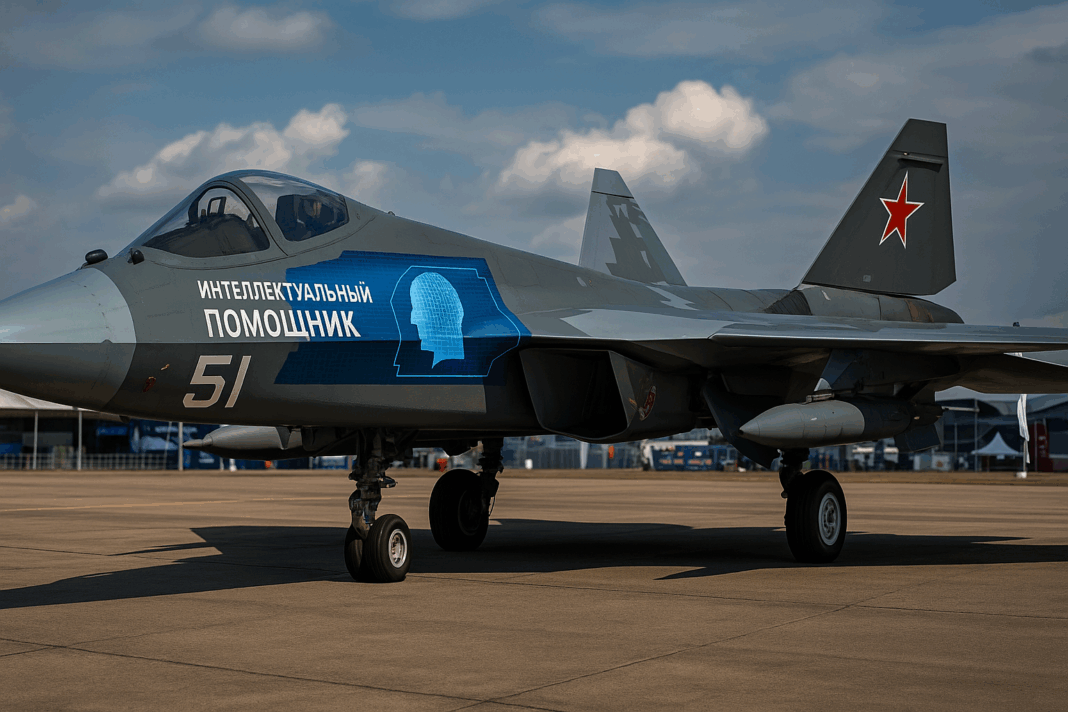The AI module, described as a “co-pilot,” is designed to aid in both combat situations and general flight tasks.
AI Feature Demonstrated on Russia’s Fifth-Generation Su-57 Jet
Russia presented a new artificial intelligence (AI)-assisted flight support system for its Su-57 fifth-generation fighter aircraft during the Langkawi International Maritime and Aerospace (LIMA) Exhibition 2025 held in Malaysia.
Officials from Rosoboronexport, Russia’s state arms exporter, confirmed that the AI system has been integrated into the export version of the Su-57, known as the Su-57E. The AI capability was among the highlighted features during Russia’s aviation technology showcase at the event.
The United Aircraft Corporation (UAC), which manufactures the Su-57, reported that the AI system functions as a virtual assistant to the human pilot. It is intended to handle various non-critical functions such as navigation, diagnostics, and threat monitoring, thereby reducing pilot workload in high-stress scenarios.
According to Rosoboronexport representatives, the AI system can provide real-time suggestions and manage certain elements of flight control. However, they emphasized that decisions related to weapons deployment remain strictly under the control of the human operator.
The integration of this AI assistant follows a global trend among advanced fighter jet programs to utilize automation to improve reaction time and reduce pilot fatigue during extended missions.
Russia’s War Machine Crumbles Under Sanctions as Another Su-25 Crashes Near North Korea
System Customization and Operational Design
The AI co-pilot system displayed on the Su-57E is described as fully customizable. Rosoboronexport officials stated that the AI’s level of intervention can be adjusted depending on the experience and training of the pilot.
For veteran pilots, the system may operate in the background, only stepping in when requested. For new users, particularly in export markets unfamiliar with Russia’s flight systems, the AI can assist in managing the aircraft’s flight path, fuel optimization, and situational awareness.
An unnamed UAC official explained during the exhibition that the AI system does not replicate autonomous combat capabilities but serves as a digital second pilot with defined limits. Tasks such as enemy detection, radar mode selection, and warning prompts can be managed by the system, while mission execution decisions remain with the human pilot.
The AI does not interfere with core avionics or weapons systems unless specifically programmed to do so within the operational parameters set by the pilot or ground crew.
The inclusion of this AI platform is reported to be a standard option in the export configuration of the Su-57E. No additional technical specifications regarding processing power, algorithm origin, or data training methodology were released.
F-22 Obliterates Russia’s Su-30 and Su-35 in Brutal Aerial Clash in Syrian Skies
Broader Context and International Exhibition Campaign
The Su-57E’s AI system is part of a broader effort by Russia to market its fifth-generation stealth fighter to international clients. The Su-57E has been showcased in multiple global arms expos, including events in Egypt, China, and India. The appearance at LIMA 2025 marks the latest phase in Russia’s outreach to Southeast Asian defense buyers.
Rosoboronexport issued a formal statement noting that the aviation segment was the central theme of the Malaysian exhibition and that the Su-57E was positioned as a core offering within Russia’s aerial defense portfolio. The statement described the AI feature as a capability relevant to modern air combat environments that involve electronic warfare and multi-domain threats.
Russia’s defense officials highlighted the operational experience of the Su-57 in real-world scenarios, stating that the platform had performed under conditions where adversaries employed advanced unmanned systems, signal jamming, and AI-driven surveillance.
Despite repeated demonstrations, there have been no confirmed international sales of the Su-57E. However, the introduction of the AI assistant was promoted as a significant addition to the jet’s existing features, which include radar stealth, supercruise capability, and multirole armament integration.
The demonstration at LIMA 2025 included static displays, simulator access, and video presentations. Live flight displays were conducted by Russian pilots, though the AI system’s performance was not showcased in open-air flight during the exhibition.
Rosoboronexport did not disclose whether any Southeast Asian air forces had requested further briefings or technology demonstrations. No technical white papers or operation manuals related to the AI system were distributed during the public portion of the event.
There was no announcement of any co-development or licensing agreements with Malaysian or regional defense industries regarding the AI platform or other Su-57E components.
Media access to the AI system remained limited to official walkthroughs, and photography of the AI interface cockpit displays was restricted. Representatives of Rosoboronexport declined to answer specific questions about the AI system’s development timeline or its compatibility with other Russian or non-Russian aircraft platforms.
The AI co-pilot system has not been presented as an autonomous combat system, and no data was provided to indicate machine learning capability beyond programmed parameters. The nature of software updates, cybersecurity protocols, or post-sale technical support also remained unspecified.
The Su-57E remains one of the few fifth-generation platforms currently being promoted to export markets, and the AI enhancement is considered one of its key differentiators in an increasingly competitive defense environment.

